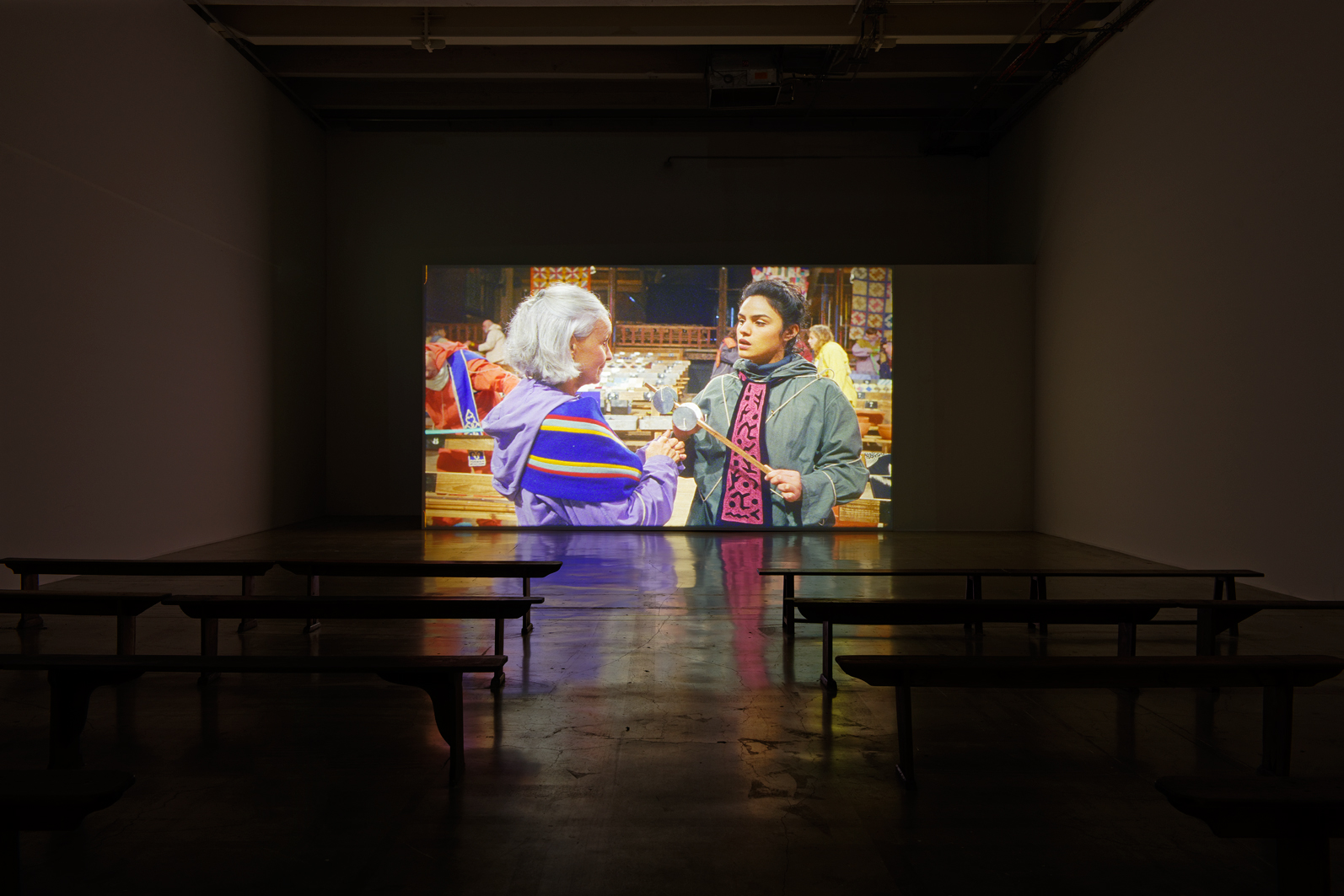« Qu’est-ce qu’une communauté ? Le peuple en soi n’existe pas. Je crois qu’on est tous assez seuls aujourd’hui. Autour de quoi les groupes existent-ils ? Existe-t-il d’autres possibilités de vie ? »
Avec ce film tourné en pellicule couleur, Ulla von Brandenburg fait basculer le visiteur dans un nouveau décor. Le voici maintenant au Théâtre du Peuple de Bussang, un théâtre érigé à flanc de montagne dans les Vosges à la fin du XIXe siècle pour offrir à l’ensemble du peuple des fêtes théâtrales. C’est dans ce lieu chargé d’un idéal humaniste qu’Ulla von Brandenburg fait évoluer ses performeurs sur un texte chanté inspiré par la pièce Le Poisson des grands fonds (Der Tiefseefisch, 1930) de Marieluise Fleisser (1901-1974). Ils interprètent une « micro-société, comme s’il s’agissait de la dernière de son espèce », une communauté vivant coupée de l’extérieur, avec sa propre économie, ses règles et ses valeurs. Leur quotidien est soudainement
interrompu lorsqu’un de ses membres brise le rituel et ouvre les portes du décor. Il révèle au spectateur la particularité du théâtre de Bussang – son fond de scène est ouvert sur la forêt – et à sa communauté la possibilité d’une ouverture vers l’extérieur. C’est à la fois une variation sur la perte, l’abandon ou la fuite tout autant qu’une réflexion, sous la forme d’un conte, sur la transgression des règles et la responsabilité
individuelle au sein du collectif.
À la fin du film, les membres de la communauté disparaissent pour réapparaître au Palais de Tokyo, les objets qu’ils emportent avec eux deviennent les œuvres de cette exposition. Ulla von Brandenburg dévoile ainsi l’illusion théâtrale et fait, à l’image de la présence d’un ours dans le film, resurgir dans notre organisation sociale ce que nous nous étions forcés à exclure : la nature et l’inconnu.
Ulla von Brandenburg, Le milieu est bleu, 2020
Film super 16 mm, transféré sur vidéo HD, couleur, son, 23’43″
Courtesy de l’artiste et Art : Concept (Paris) ; Meyer Riegger (Berlin/Karlsruhe) ; Pilar Corrias Gallery (London) ; Produzentengalerie Hamburg
Réalisatrice : Ulla von Brandenburg
Productrice exécutive : Julia Mossé
Dramaturge : Benoit Résillot
Chorégraphe : Giuseppe Molino
Scénographie : Valentina Dotti, Sabine Tarry, Julia Mossé, Julien Crépieux
Accessoires : Hannelore Lücke-Rausch, Fabienne
Touzi dit Terzi, Julien Crépieux, Adrien Collino, Charlotte Livine, Charles Poitevin / Costumes : Valentina Dotti, Sabine Tarry, Julia Mossé, Clémence Joly, Fanny Milone, et avec le soutien de l’Opéra National de Paris
Musique : Anna Holveck, Ulla von Brandenburg
Directeur de la photographie : Laurent Coltelloni
Cadreur et opérateur steadicam : Eric Bialas
Premier assistant caméra : Mathias Sabourdin
Chef électricien : Luis Peralta
Chef machiniste : Pierre Monneret
Régisseur général : Nicolas Galland
Technicien électricien : Alban Thiébaut
Ingénieur du son : Olivier Pelletier
Montage et étalonnage : Nicolas Perret, Laurent Coltelloni Postproduction : Alexandre Westphal
Équipement : Kodak France, Panavision Paris et Panalux Paris Laboratoire : Hiventy, Joinville-Le-Pont
Performeuses / Performeurs : Benoit Résillot, Giuseppe Molino, Laurence Mayor, Bianca Iannuzzi, Duncan Evennou, Larissa Emi,
Jean-Marc Michels, Julia Mossé
Figuration : Pauline-Alexandrine Deforge, Valentina Dotti, Anna Holveck, Ulla von Brandenburg, Sabine Tarry, Julien Crépieux,
Alice Monneret, Pascal Alexandre, Aurélia Barraux, Maud Chasseux, Christine Frechin, Grégory Gillar, Alain Grivel, Maryvonne Hans,
Pascalle Henry, Martial Imbault, Anne Jacquot, Laurence Joly, Céline Motte, Linda Nachtigall, Christine Peyrole, Catherine Poirot,
Josette Prud’homme, Odile Rose, Evelyne Saint Dizier, Bénédicte Thiebaut
Catering : Pascal Bernard
Remerciements : Simon Delétang, Alice Trousset, Clélie Bagard et toute l’équipe du Théâtre du Peuple, Bussang ; Yoann Gourmel,
Albane de Chatellus, Christine Neumeister, Marianne Lamour, Vincent Ferreira, Jessica Nourisson, Pierre-Marie Paubel, Matthieu Imbert
EN PARTENARIAT AVEC LE THÉÂTRE DU PEUPLE, BUSSANG, LE CND, CENTRE NATIONAL DE LA DANSE ET
L’OPÉRA NATIONAL DE PARIS
